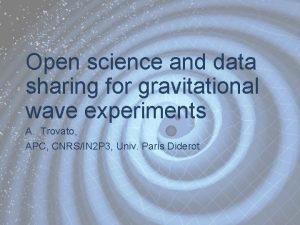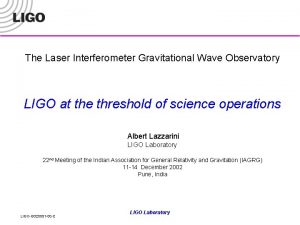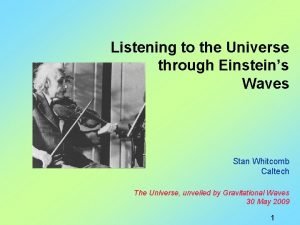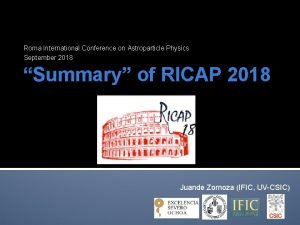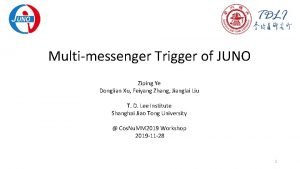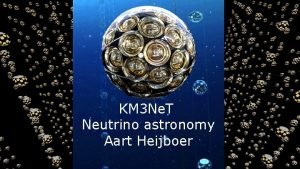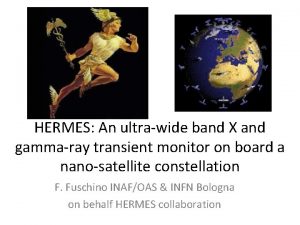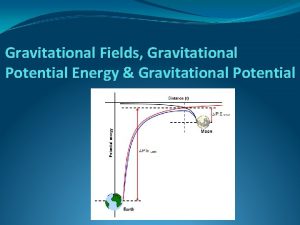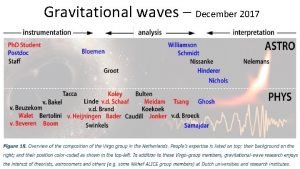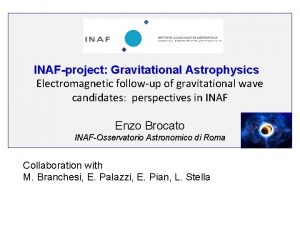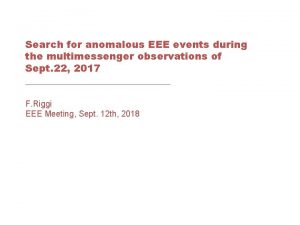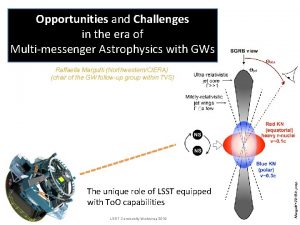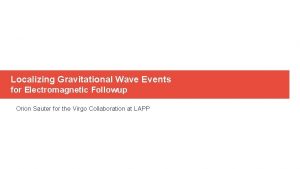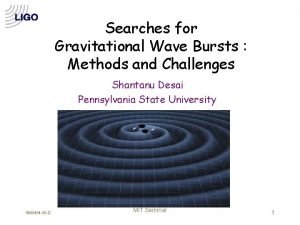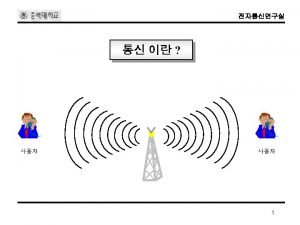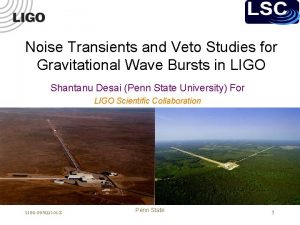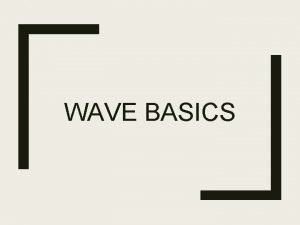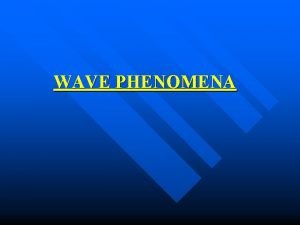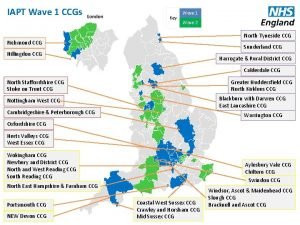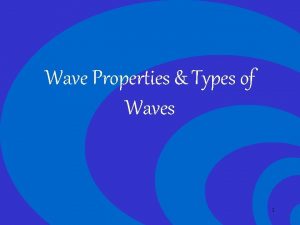MultiMessenger Studies with Gravitational Wave Events Challenges and






















- Slides: 22

Multi-Messenger Studies with Gravitational Wave Events Challenges and Opportunities Jochen Greiner Max-Planck Institut für extraterrestrische Physik, Garching Astroparticle Physics in Germany, Mainz, 17. -19. 9. 2018

“LIGO: A discovery that shook the world” Ø GW 170817 was breakthrough in GW astrophysics Ø Quality and quantity of EM counterpart observations is staggering https: //www. youtube. com/watch? v=-Yt 5 Em. Egz 2 w Astroparticle Physics in Germany, Mainz, 17. -19. 9. 2018

Contemporaneous GW & γ-ray Detection Nomenclature: the event was on 17. August 2017 GRB 170817 A GW 170817 AT 2017 gfo (kilonova) To be fair: Without GW detection this GRB would be just another among 2000 Fermi/GBM GRBs with nothing than γ-ray data: No kilonova, no afterglow, no distance, no jet structure and geometry details, no wondering about low luminosity truly multi-messenger event Ø no LIGO auto-detection due to noise glitch Abbott et al. 2017, Ap. J Ø manual LIGO check after automatic GBM trigger after 27 min: the coincidence was recognized New era had begun! …and at least 1000 astronomers Astroparticle Physics in Germany, Mainz, 17. -19. 9. 2018 knew it at this time

Multi-wavelength follow-up observations automatic multi-directional info exchange via GRB emailnetwork: To+25 s: first Fermi/GBM email To+27 min: LIGO info (NS) 192 emails followed 1/3 of all observational astronomers worldwide were involved optical Radio γ-rays, X-rays Neutrinos Astroparticle Physics in Germany, Mainz, 17. -19. 9. 2018 Abbott et al. 2017, PRL § §

Combination of different astrophysics Stellar evolution – NS-NS merger – Neutrino emission - Accretion – Jets – Gamma-ray burst – Nucleosynthesis – Chemical evolution Astroparticle Physics in Germany, Mainz, 17. -19. 9. 2018 Tsujimoto+2014 4 different observational phenomena Ø Gravitational waves (GW) Ø Short Gamma-ray burst (GRB) Ø Kilonova Ø GRB afterglow Plan of talk Ø what did we learn? Ø what else can we learn? Ø prospects

Short GRBs • due to NS-NS merger (Eichler+1989) • typical jet opening angles ~5 -10 o • closest known short GRB: 080905 at z=0. 1218 (570 Mpc) • thus, for any short GRB within the a. LIGO horizon we expected (1) 100 -1000 LIGO detections of NS-NS mergers without a GRB (2) monster-bright γ-ray emission Instead, the first LIGO detection of a NS-NS merger comes with a weak GRB! Total surprise! Shows our incomplete/biased knowledge! Astroparticle Physics in Germany, Mainz, 17. -19. 9. 2018

Gamma-Ray Burst 170817 A Ø Ø Both Gamma-ray instruments developed at MPE Garching Fermi/GBM localization consistent with LIGOs INTEGRAL/ACS’ temporal structure sharper With D~40 Mpc: GRB is underluminous by 10. 000 x! Astroparticle Physics in Germany, Mainz, 17. -19. 9. 2018

GRB jet structure and viewing geometry Astroparticle Physics in Germany, Mainz, 17. -19. 9. 2018 Troja et al. 2018 Mooley et al. 2018, Nature • no afterglow during first 10 d: slow rise suggest off-axis geometry • superluminal motion of compact radio emission from afterglow • together with flux evolution: very narrow jet • jet opening angle: 4 o observed off-axis • off-axis angle of observer: 20 o • consistent with LIGO limit of <28 o for inclination of orbital plane (under assumption of jet being perpendicular to NS-NS orbit)

The GRB prompt emission spectrum Constraints on synchrotron emission models a. Structured or on-axis top-hat jet Begue, JG et al. 2017, Ap. J Lorentz factor of accelerated e- is γe = κmp/me κ parametrizes uncertainty of acceleration ξ < 1 fraction of accelerated eα < 1 fraction of E turned into radiation αξ extremely tiny for GRB 170817 A: impossible ξ « 1 small efficiency α « 0. 01 incompatible with relativ. jet b. off-axis top-hat jet Γ<20 at θ~10 o for Epeak difference incompatible with compactness Emission mechanism is very unlikely synchrotron Astroparticle Physics in Germany, Mainz, 17. -19. 9. 2018 1047 erg/s 1052 erg/s

Kilonova AT 2017 gfo Kasen et al. 2017, Nat 551, 80 produced by successive n-capture reactions (with intermittant β-decay) early blue component late red component from outflow from very n-rich ejecta needs n-rich process NS Merger Astroparticle Physics in Germany, Mainz, 17. -19. 9. 2018

Nucleosynthesis from merging NSs Barnes+2016 Smartt, JG+2017 which isotopes? • heavy (up to A~195) ? ? • lighter (A<130) ? ? (both provide acceptable fits!) Astroparticle Physics in Germany, Mainz, 17. -19. 9. 2018 Rosswog+2018 1. light curve and color evolution of KN are consistent with r-process But no, we have not seen gold

Radioactivity from Kilonova Relatively slow decay of optical light curve of kilonova: Potentially, gamma-ray line measurements could decide between radioactivity or (e. g. Dai+2017) pulsar/magnetar power, but likely not in near future (1 Mpc limit vs. GRB distances) SPI ~Me. V Astroparticle Physics in Germany, Mainz, 17. -19. 9. 2018 Hotokezaka+ 2016

What did we learn? Answers to… …expected, old questions: Ø short GRBs are indeed due to merging NS Ø GRB jets are narrow Ø theoreticians have grossly predicted the KN signal correctly (duration; luminosity ~1000 x nova) Ø light curve and color evolution of KN are consistent with r-process blue component suggestive of merger into a magnetar; red component is likely combination of tidal material and disk wind …unexpected, new questions/problems: Ø GRBs emit off-axis γ-rays Ø the γ-ray emission mechanism in short GRBs is different than previously thought Øthere are indeed ‘red’ and ‘blue’ components in kilonovae: but they are not mutually exclusive; instead, they come together Astroparticle Physics in Germany, Mainz, 17. -19. 9. 2018

Open questions Ø what is the emission mechanism in short GRBs? How does off-axis emission (luminosity, spectrum, variability, polarization) scale with Γ? Ø If off-axis γ-ray emission is typical, there should be many local GRBs! Where are they? Why has Swift not seen a single one at <570 Mpc? ? Ø simultaneous blue/red components in kilonovae: How to explain the optical/NIR light curve? Do all KN have this blue/red components? What is the effect of viewing angle? Ø final merger product: NS or black hole? Ø how will BH-NS merger look like? Ø need better atomic data for (light) r-process elements Astroparticle Physics in Germany, Mainz, 17. -19. 9. 2018 Metzger et al. 2017, Science

Predictions I: Rates of nearby GRBs • if GRBs also emit off-axis, then there will be many more of those • rate depends on relative luminosity ratio and jet opening angle Burgess, JG et al. 2017 Nominal on-axis emission within 10 o, beyond power-law decline up to 90 o Janka et al. 2006 Astroparticle Physics in Germany, Mainz, 17. -19. 9. 2018 at faint flux levels, local off-axis GRBs dominate

NS-NS merger rate • LIGO detection suggests rate of 1. 5+3. 2 -1. 2 yr-1 (per 100 Mpc 3) • 3 known channels • field binary evolution • globular clusters • nuclear clusters • highest rate is from classical isolated binary evolution: 10 -2 yr-1 Either rare event, or unknown binary channel with more frequent NS-NS mergers Astroparticle Physics in Germany, Mainz, 17. -19. 9. 2018 Belczynski et al. 2018, A&A

Predictions II: GW detectors Ø Advanced LIGO / Virgo Plan now 2/2019 ~2020 ~2022 ~2024 ~2032? ? Ø Next few years will bring hundreds of of GW triggers Ø GW localizations will improve, but generally 10 -50 x larger than that of GW 170817 Astroparticle Physics in Germany, Mainz, 17. -19. 9. 2018 upgrade O 3 Start, incl. Virgo full design-sensitivity KAGRA (Japan) LIGO India LISA

Predictions III: multi-λ instruments Wavelength # src FOV / □o Sensitivity instruments γ-rays 0 ++ - Fermi/GBM, INTEGRAL/ACS X-rays 2 + -- Swift (tiling), MAXI UV 10 -- - - Optical/NIR 1000 + - many IR 50 -- -- - Radio 2 - - LOFAR Largest progress possible: with new, more sensitive γ-ray detector Astroparticle Physics in Germany, Mainz, 17. -19. 9. 2018

How would a new gamma-ray detector help? Ø Ø Better localization More accurate time difference between merger (GW) and GRB Better spectroscopy to understand the emission process Possibly measure γ-ray polarization to understand the emission process Ø Measure nuclear lines in nearby SN explosions to understand the basics (unlikely to detect nuclear lines from NS-NS merger even with next generation Me. V telescope) Astroparticle Physics in Germany, Mainz, 17. -19. 9. 2018

Predictions IV: GW counterparts & science Ø for majority (large off-axis angles): no GRB, no afterglow, possibly kilonova within LIGO volume Ø for few: GRB, KN, but no AG Ø for very few: GRB, AG, KN (as 170817) Likely: Ø Kilonova behavior / statistics (not necessarily r-process details) Ø BH-NS merger Ø Unexpected new phenomenon Ø cosmology: Ho (needs a few dozen GRBs) Possibly: Ø Off-axis radiation (process) of short GRBs / Jet physics Ø Possibly inferences on NS radii and equation of state Astroparticle Physics in Germany, Mainz, 17. -19. 9. 2018

BH-BH and BH-NS merger Ø Several BH-BH mergers seen by a. LIGO § None has shown a convincing EM counterpart (claim for EM of first merger, GW 150914, disproven) this is consistent with many earlier predictions, though 150914 sparked the phantasy of some theoreticians § But: we should keep open-minded, and continue searching Astroparticle Physics in Germany, Mainz, 17. -19. 9. 2018 Greiner+2016 Connaughton+2016 Ø BH-NS merger: still un-observed by a. LIGO/Virgo case for EM counterpart completely open

Summary Ø New era (multi-messenger & multi-wavelength) Ø more new questions than solved problems (nice!) Ø Urgent need for better § γ-ray mission (sensitivity & localization) § Atomic data of (light) r-process elements Ø Many expectations: KN, off-axis emission mechanism, BH-NS merger, likely also unexpected surprises § Pessimistic view: GW 170817 was unique event; no NS-NS merger(s) in O 3 § Optimistic view: off-axis emission and 100 x more frequent NSNS binaries are the rule, then handful of new NS-NS mergers in O 3 (2019) Astroparticle Physics in Germany, Mainz, 17. -19. 9. 2018
 Gravitational wave open science center
Gravitational wave open science center Gravitational wave
Gravitational wave Gravitational wave
Gravitational wave Giant gravitational wave murmurs universe
Giant gravitational wave murmurs universe Wave could hear murmurs across universe
Wave could hear murmurs across universe Vodafone multimessenger
Vodafone multimessenger Multimessenger
Multimessenger Multimessenger
Multimessenger Kilonova
Kilonova Multimessenger
Multimessenger Multimessenger
Multimessenger Multimessenger
Multimessenger Difference between full wave and half wave rectifier
Difference between full wave and half wave rectifier Transverse and longitudinal waves both *
Transverse and longitudinal waves both * Full wave vs half wave rectifier
Full wave vs half wave rectifier Earthquake p wave and swave travel time
Earthquake p wave and swave travel time Mechanical wave and electromagnetic wave
Mechanical wave and electromagnetic wave Mechanical waves and electromagnetic waves similarities
Mechanical waves and electromagnetic waves similarities Velocity frequency wavelength triangle
Velocity frequency wavelength triangle Mutually exclusive events vs not mutually exclusive events
Mutually exclusive events vs not mutually exclusive events Paradigm shift from women studies to gender studies
Paradigm shift from women studies to gender studies Light is an electromagnetic wave true or false
Light is an electromagnetic wave true or false Long waves and short waves
Long waves and short waves
